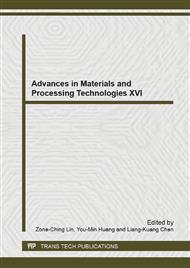[1]
A. Jorio, M.S. Dresselhaus, G. Dresselhaus, Carbon Nanotubes: Advance Topics in the Synthesis, Structure, Properties and Applicantions, Springer Publisher, Berlin (2008).
DOI: 10.1007/978-3-540-72865-8
Google Scholar
[2]
M. S. Dresselhaus, G. Dresselhaus, P. Avouris, Carbon Nanotubes: Synthesis, Structure, Properties and Applications (Topics in Applied Physics, vol. 80), European Journal of Control 15, no. 1 (2009).
DOI: 10.1007/3-540-39947-x
Google Scholar
[3]
M. Meyyappan, Carbon Nanotubes: Science and Applications, CRC Press, Boca Raton (2005).
Google Scholar
[4]
T. Akasaka, F. Wudl, S. Nagase, Chemistry of nanocarbons, Wiley, West Sussex (2010).
Google Scholar
[5]
X. Peng, J. Chen, J.A. Misewich, S.S. Wong, Carbon nanotube - nanocrystal heterostructures, Chemical Society Reviews 38/4 (2009) 1076-1098.
DOI: 10.1039/b811424m
Google Scholar
[6]
Y. Xing, Synthesis and electrochemical characterization of uniformly-dispresed high loading Pt nanoparticles on sonochemically-treated carbon nanotubes, The Journal of Physical Chemistry B 108 (2004) 19255-19259.
DOI: 10.1021/jp046697i
Google Scholar
[7]
L. Li, Y. Xing, Pt-Ru Nanoparticles Supported on Carbon Nanotubes as Methanol Fuel Cell Catalysts, Journal of Physical Chemistry C 111 (2007) 2803-2808.
DOI: 10.1021/jp0655470
Google Scholar
[8]
G.G. Wildgoose, C.E. Banks, R.G. Compton, Metal Nanoparticles and Related Materials Supported on Carbon Nanotubes, Methods and Applications 2/2 (2006) 182-193.
DOI: 10.1002/smll.200500324
Google Scholar
[9]
V. Georgakilas, D. Gournis, V. Tzitzios, L. Pasquato, D.M. Guldi, M. Prato, Decoration carbon nanotubes with metal or semiconductor nanoparticles, Journal of Materials Chemistry 17 (2007) 2679-2694.
DOI: 10.1039/b700857k
Google Scholar
[10]
M. Pawlyta, D. Łukowiec, A.D. Dobrzańska-Danikiewicz, Characterisation of carbon nanotubes decorated with platinum nanoparticles, Journal of Achievements in Materials and Manufacturing Engineering 53/2 (2012) 67-75.
DOI: 10.4028/www.scientific.net/msf.783-786.1503
Google Scholar
[11]
Y. Xia, Y. Xiong, B. Lim, S.E. Skrabalak, Shape-controlled synthesis of metal nanocrystals: Simple chemistry meets complex physics, Angewandte Chemie International Edition 48 (2009): 60-103.
DOI: 10.1002/anie.200802248
Google Scholar
[12]
J. Kong, N.R. Franklin, C. Zhou, M.G. Chapline, S. Peng, K. Cho, H. Dai, Nanotube molecular wires as chemical sensors, Science 287/5453 (2000): 622 - 625.
DOI: 10.1126/science.287.5453.622
Google Scholar
[13]
W.D. Zhang, W. H. Zhang, Carbon Nanotubes as Active Components for Gas Sensors, Journal of Sensors, Vol. 2009, Article ID 160698, 16 pages, 2009. doi: 10. 1155/2009/160698.
DOI: 10.1155/2009/160698
Google Scholar
[14]
N. Sinha, J. Ma, J.T.W. Yeow, Carbon Nanotube - Based Sensors, Journal of Nanoscience and Nanotechnology 6 (2006) 573–590.
DOI: 10.1166/jnn.2006.121
Google Scholar
[15]
A. Star, V. Joshi, S. Skarupo, D. Thomas, J. CP Gabriel, Gas sensor array based on metal-decorated carbon nanotubes, The Journal of Physical Chemistry B 110/42 (2006) 21014-21020.
DOI: 10.1021/jp064371z
Google Scholar
[16]
D.R. Kauffman, D.C. Sorescu, D.P. Schofield, B.L. Allen, K.D. Jordan, A. Star, Understanding the Sensor Response of Metal-Decorated Carbon Nanotubes, Nano Letters 10 (2010) 958–963.
DOI: 10.1021/nl903888c
Google Scholar
[17]
R. Ströbel, J. Garche, P.T. Moseley, L. Jörissen, G. Wolf, Hydrogen storage by carbon materials, Journal of Power Sources 159/2 (2006) 781-801.
DOI: 10.1016/j.jpowsour.2006.03.047
Google Scholar
[18]
T. Yildirim, S. Ciraci, Titanium-Decorated Carbon Nanotubes as a Potential High-Capacity Hydrogen Storage Medium, Physical Review Letters 94/17 (2005) 175501.
DOI: 10.1103/physrevlett.94.175501
Google Scholar
[19]
P. Brown, K. Takechi, P.V. Kamat, Single-Walled Carbon Nanotube Scaffolds for Dye-Sensitized Solar Cells, The Journal of Physical Chemistry C 112/12 (2008) 4776-4782.
DOI: 10.1021/jp7107472
Google Scholar
[20]
M. Bottini et al., Full-length single-walled carbon nanotubes decorated with streptavidin-conjugated quantum dots as multivalent intracellular fluorescent nanoprobes, Biomacromolecules 7/8 (2006) 2259-2263.
DOI: 10.1021/bm0602031
Google Scholar
[21]
K. Lee, J. Zhang, H. Wang, D.P. Wilkinson, Progress in the synthesis of carbon nanotube - and nanofiber - supported Pt electrocatalysts for PEM fuel cell catalysis, Journal of Applied Electrochemistry 36 (2006) 507–522.
DOI: 10.1007/s10800-006-9120-4
Google Scholar
[22]
K. Jiang, A. Eitan, L.S. Schadler, P.M. Ajayan, R.W. Siegel, Selective Attachment of Gold Nanoparticles to Nitrogen-Doped Carbon Nanotubes, Nano Letters 3/3 (2003) 275-277.
DOI: 10.1021/nl025914t
Google Scholar
[23]
Q.C. Shi, T.Z. Peng, A novel cholesterol oxidase biosensor based on Pt-nanoparticle/carbon nanotube modified electrode, Chinese Chemical Letters 16/8 (2005) 1081-1084.
Google Scholar
[24]
H. F Cui, J.S. Ye, X. Liu, W.D. Zhang, F.S. Sheu, Pt-Pb alloy nanoparticle/carbon nanotube nanocomposite: a strong electrocatalyst for glucose oxidation, Nanotechnology 17 (2006) 2334-2339.
DOI: 10.1088/0957-4484/17/9/043
Google Scholar


